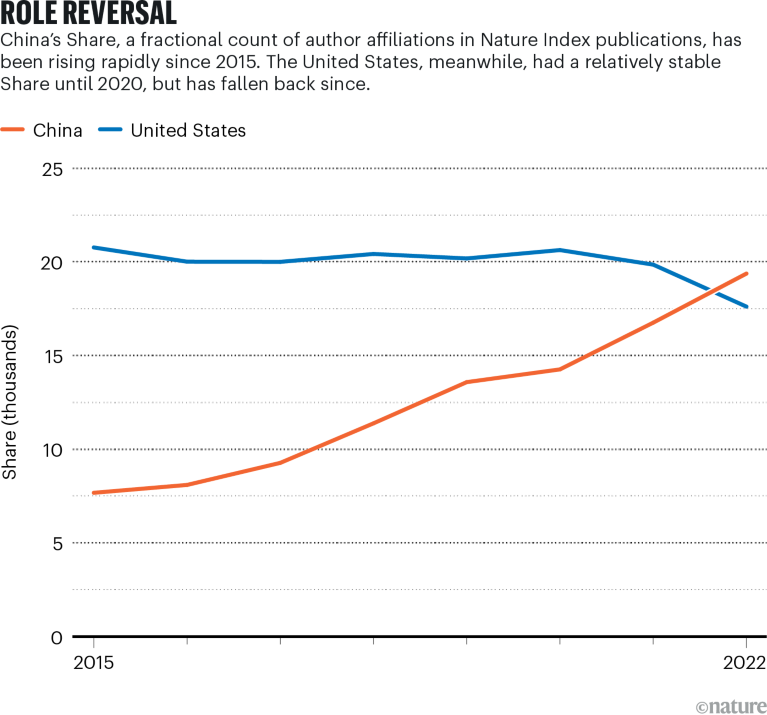Since the Nature Index was first introduced in 2014, China’s Share has been rapidly gaining ground, and it was the leading country in the physical sciences and chemistry in 2021.
The latest data — a snapshot of the database taken in April, ahead of the full release of 2022 data in the 2023 Nature Index annual tables — suggest that China also overtook the United States in Earth and environmental sciences for the first time. This leaves only one natural-sciences category — life sciences — in which it is still trailing.
China overtakes United States on contribution to research in Nature Index

The Chinese Academy of Sciences’s Ming’antu observing station in China’s Inner Mongolia autonomous region.Credit: Lian Zhen/Xinhua/Alamy
"For the first time, China has overtaken the United States as the number one ranked country or territory for contributions to research articles published in the Nature Index group of high-quality natural-science journals.
Data on author affiliations from the 82 journals tracked by the Nature Index show that China had a Share of 19,373 from January to December 2022, compared with 17,610 for the United States (see ‘Role reversal’).
A country’s Share takes into account the percentage of authors from that nation on each paper published in Nature Index journals; an article published entirely by China-based researchers would yield a Share of 1 for China.
Shifting balance
Different measures of scientific performance have been pointing to a shift in the national balance of global science since the mid-2010s: a 2018 US National Science Foundation data set showed that China published the largest number of papers, for example.
The focus in the past five years has been on when China might overtake the United States on metrics that attempt to measure quality, such as assessments of citation numbers.
For instance, a 2022 report by Japan’s National Institute of Science and Technology Policy used fractional counting, or the percentage of authors from a given country on a paper, to determine contributions to highly cited research. It found that, between 2018 and 2020, Chinese research comprised more of the top 1% of the most frequently cited papers than did US research.

Source: Nature Index
Although the Nature Index does not assess citations, it tracks journals, selected by an independent group of actively publishing researchers, that are intended to represent a consensus of the upper echelon of journals in the natural sciences. (Nature Index’s news and supplement content is editorially independent of its publisher, Springer Nature.)
Caroline Wagner, a science and policy researcher at the Ohio State University in Columbus, who has published research1 suggesting that China has overtaken the United States on top-cited papers, says that, when measured on “simple bibliometrics like productivity and citations, China has outperformed expectations”.
She adds, however, that it still “significantly trails” behind other nations “in its capacity to absorb and apply knowledge”, and that the impact of the decline in its research collaborations with some major countries, such as the United States, remains uncertain. . .
Alternative angles
The Nature Index data do show that China has still a way to go before it catches the United States on Count, a raw sum of all articles in the database that have at least one author from a particular country. In the same January to December 2022 window, the United States had a Count of almost 25,200 articles, compared with slightly more than 23,500 for China.
A brief guide to the Nature Index
In two major multidisciplinary journals included in the Index, Nature and Science, the United States had a Share of 786, much higher than China’s 186.
The 2023 Nature Index annual tables, due for release in mid-June, will provide a full breakdown of the institutions that have helped to propel China to the top in Share last year.
The tables will also feature, for the first time, data on publications in a set of high-quality medical journals that will be added to the Nature Index, so that users can also track trends in the health sciences."
doi: https://doi.org/10.1038/d41586-023-01705-7


No comments:
Post a Comment